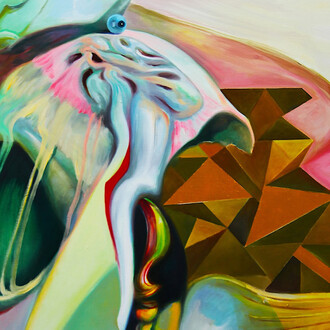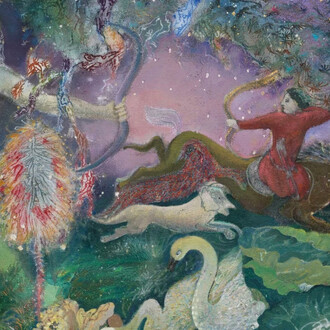The vegetation that grows along the edges of busy roads is dirty and tenacious, dusty and neglected. While it may play a supporting role in a certain kind of cinema, it almost never plays one in the history of painting. Yet Soumya Netrabile pays attention to it, portraying it and sometimes even elevating it to a metaphor for her own painting practice: anthropic jetsam (a ticket, some litter thrown out of a car window) are caught amid the grass and shrubs with the same intensity with which the painter’s swooping brushstrokes ensnare the human figure.
Netrabile’s nature is neither Edenic nor bucolic; it is not studied in terms of harmony and chaos, and nor does it act as a theatre for the sublime. It is not heroic, nor does it set the stage for defeat: it looks like a dirty tablecloth at the end of a meal, after having hosted humankind, still bearing traces of it. Netrabile calls it the “humanistic turn” of her own painting.
Netrabile thinks about the painting as an ecosystem crossed by a circulatory system based on color, which according to the artist houses both nutrients and pathogens. In this complex mechanism, at the level of subject matter, Netrabile appears to cultivate a predilection for what is domestic and outcast, minimal and dispensable. The landscape of a rest area, the arborvitaes that mark the perimeter of the Common Man’s garden, a shrub beneath the guardrail.
The painter’s gaze does not analyze her subject from a socio-anthropological or eco-political point of view; rather, she places herself at the level of what she paints—or sometimes lower—like a little cricket swept up in the winds. Such a microscopic perspective keeps Netrabile within the framework of an abstract painter who identifies her subject in the landscape, or rather in nature, yet only provisionally.
The words of Émile Zola seem to echo: “a work of art is a corner of nature seen through a temperament”. Netrabile’s work can be ascribed to a genre of contemporary painting that finds its main feature in an extremely emotional and expressionist gestural handling of color. Nonetheless, what distinguishes Netrabile from her contemporary colleagues is that she does not refer to an idealized or dreamlike or whimsical nature, nor one functional to the painting itself, but rather to a nature that comes from observing the Midwest in strong syncretism with older personal recollections and with a complex set of feelings toward them. One may glimpse the detail of Indian miniature slipping into the memory of blood in Netrabile’s shrubs, often outlined by brushstrokes with a decorative touch and hieratic semblance, or in her animals, whose gaze often replaces that of the human subject and does so with greater intensity.
Holding Current, the title of the exhibition, harks back to the painter's electrical engineering education. “In electrical theory, the holding current is the minimum charge required for a circuit to stay on the ON state. I like to think of it also a state of mind I need to hold while working on a painting. I also think of air currents and how they too can carry a charge, one which if paid attention to, might offer meaningful weight to the experience of a particular time and place”, says Netrabile.
Although Netrabile has been focusing predominantly on studying Cézanne's paintings for the last two years, looking at some of her more frantic landscapes where the brushstrokes devour the signs of anthropization, we are reminded of coeval but far more entropic American landscape painters, from Louis Eilshemius to Albert Pinkham Ryder.
Some of the ten paintings on display in this exhibition feature deep incisions carved out with a metal scraper tool, evoking a sense of rebellion and rupture with the classical genre; other paintings draw on a more gentle alternation of concave and convex planes in the Munchian manner, but all Netrabile’s paintings speak of a feverish, edgy temperament. They evoke the spirit of a painter living inside a wound, obscured by the copresence of sun and moon, like in the ancient iconography of crucifixion. Everything is tinged with red and brown hues that appear to dominate the greens and yellows; ultimately, everything is filtered through the smell of blood—not the one from outside us, not the one that rules history, but our own.
(text by Sofia Silva)
Soumya Netrabile (b. 1966, Bangalore, India) received a BFA from the School of Art Institute of Chicago and a BS in Electrical Engineering from Rutgers University. Recent solo exhibitions include Rachel Uffner Gallery (New York, NY); Andrew Rafacz (Chicago, IL); Anat Egbi (Los Angeles, CA); Gana Art (Seoul, South Korea); Pt.2 Gallery (Oakland, CA); and The Journal (New York, NY). Recent group exhibitions include Andrew Rafacz (Chicago, IL); Anat Egbi (Los Angeles, CA); Rachel Uffner Gallery (New York, NY); Trinta Gallery (Santiago de Compostela, Spain); Indigo + Madder (London, UK); and Karma (New York, NY). Netrabile has exhibited in art fairs in Chicago, Miami, New York, San Francisco, Dallas, Seoul, and Hong Kong. Her work is in the public collections of the Orange County Museum of Art (Costa Mesa, CA); Crocker Art Museum (Sacramento, CA); University Club of Chicago (Chicago, IL); Aïshti Foundation (Jal El Dib, Lebanon); and Museu Inimá de Paula (Belo Horizonte, Brazil). Netrabile lives and works in Chicago, IL.
















